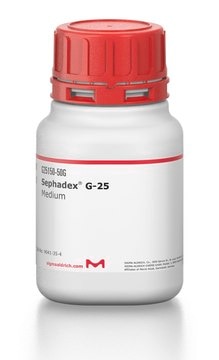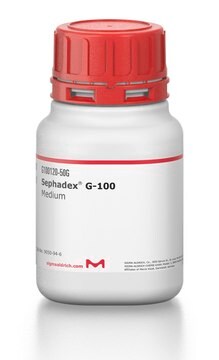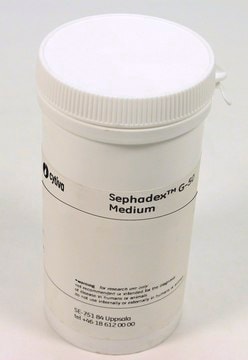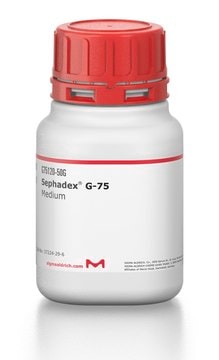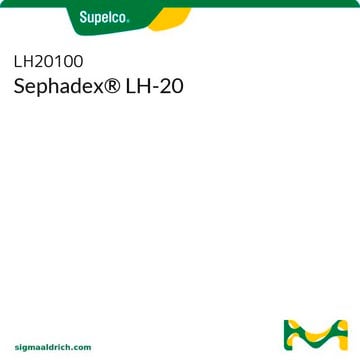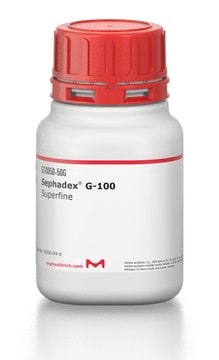The specific concentration of non-ionic detergent for cleaning Sephadex Media is not explicitly mentioned in the available data. However, various sources suggest concentrations ranging from 0.1 – 0.5%. This information has not been validated. The general cleaning recommendations are as follows:
1. Wash with two column volumes of 0.2 M NaOH or a solution of a nonionic detergent. Washing the more porous Sephadex types (G-50 – G-200) with NaOH should be done outside the column because the gel will swell.
2. Re-equilibrate the gel with 2–3 column volumes of buffer before your next experiment. When necessary, the gel can be removed from the column and sterilized by autoclaving at 120 °C, pH 7.
G5080
Sephadex® G-50
Fine
Sinonimo/i:
Gel filtration resin, Sephadex G-50 Fine Medium
Scegli un formato
139,00 €
Scegli un formato
About This Item
139,00 €
Prodotti consigliati
Livello qualitativo
tecniche
affinity chromatography: suitable
Gruppo funzionale matrice
phase
Rigonfiamento
1 g swells to 9-11 mL
Dimensioni delle microsfere
20-80 μm
applicazioni
life science and biopharma
Compatibilità
Cytiva
Descrizione generale
Fractionation Range (MW)
Globular Proteins: 1,500 - 30,000
Dextrans: 500 - 10,000
Applicazioni
- to remove the non-entrapped carboxyfluorescein (CF) from the liposome suspension[1]
- in the purification of monoclonal antibody (mAb) humanized MN-14 by centrifuged size-exclusion chromatography[2]
- in desalting the recombinant enzymes eluted in the fraction five and six[3]
- the separation of low and high molecular weight molecules
- affinity chromatography, protein chromatography, and gel filtration chromatography
Caratteristiche e vantaggi
- Desalts, removes contaminants, and transfers to a new buffer in one step.
- Suitable for DNA purification from small molecules using gel filtration.
- Features a small bead size, resulting in shorter diffusion distances.
- Considered a classic gel filtration resin.
- Desalting with Sephadex is considered superior to dialysis because it saves time, has a low dilution factor, and recovers high activity even with minute amounts of sample
Altre note
G5080-500G′s updated product number is GE17-0042-02
Note legali
Sostituito da
Codice della classe di stoccaggio
11 - Combustible Solids
Classe di pericolosità dell'acqua (WGK)
WGK 3
Punto d’infiammabilità (°F)
Not applicable
Punto d’infiammabilità (°C)
Not applicable
Dispositivi di protezione individuale
Eyeshields, Gloves, type N95 (US)
Scegli una delle versioni più recenti:
Certificati d'analisi (COA)
Non trovi la versione di tuo interesse?
Se hai bisogno di una versione specifica, puoi cercare il certificato tramite il numero di lotto.
Possiedi già questo prodotto?
I documenti relativi ai prodotti acquistati recentemente sono disponibili nell’Archivio dei documenti.
I clienti hanno visto anche
-
What concentration of non-ionic detergent should be used for cleaning of G50 resins
1 risposta-
Utile?
-
-
Can I use this for spin columns?
1 risposta-
Yes, this product can be used for spin columns. For a prepared version, please view the Roche Quick Spin columns. See the link below to review this product:
https://www.sigmaaldrich.com/product/roche/11274015001Utile?
-
-
How stable is Sephadex® G-50, Product G5080, after swelling?
1 risposta-
Sephadex® is stable in water, salt solutions, organic and denaturing solvents. If necessary, the gel can be removed from the column and sterilized by autoclaving at 120 deg C, pH 7. The pH stability is limited to low strengths and short times at extremes of pH 2-10, particularly in the acid range. After any washes using solutions at extremes of acidic or basic pH, the Sephadex® should be washed and reequilibrated with buffer at neutral pH as promptly as possible.
Utile?
-
-
What does "G-50" mean in Sephadex® G-50, Product G5080?
1 risposta-
"G" stands for gel. "50" refers to the water regain of the gel, in this instance, 5.0 g water per g dry gel.
Utile?
-
-
What is the best buffer to use with Sephadex® G-50, Product G5080?
1 risposta-
Sephadex® G-50 is very flexible in the buffers that can be used with it. Essentially any common aqueous buffer can be used with Sephadex® G-50. It is advised to filter buffers through a 0.22 micron filter before use.
Utile?
-
-
What kind of separation can I expect from Sephadex® G-50, Product G5080?
1 risposta-
As a general rule of thumb, Sephadex® G-50 is appropriate for the separation of molecules of ~30 kDa from molecules ~1.5 kDa
Utile?
-
-
How can I clean the Sephadex® G-50, Product G5080, after use?
1 risposta-
To clean the gel, you can wash the gel with 2 column volumes (CV) of 0.2 M NaOH, outside of the column because the gel will swell in basic pH, or in a solution of non-ionic detergent. Then you can rinse with water and re-equilibrate with 2-3 CV of buffer. If the resin is to be stored (longer than ~24 hours), equilibrate the resin with buffer containing an antimicrobial such as 20% ethanol or 0.02% sodium azide.
Utile?
-
-
What is the Department of Transportation shipping information for this product?
1 risposta-
Transportation information can be found in Section 14 of the product's (M)SDS.To access the shipping information for this material, use the link on the product detail page for the product.
Utile?
-
Filtri attivi
Il team dei nostri ricercatori vanta grande esperienza in tutte le aree della ricerca quali Life Science, scienza dei materiali, sintesi chimica, cromatografia, discipline analitiche, ecc..
Contatta l'Assistenza Tecnica.

